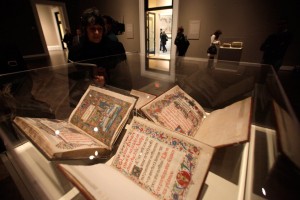 A collection of rare illuminated manuscripts that were once in the Sacristy of the Sistine Chapel are on display at Southern Methodist University’s Meadows Museum from today until April 23rd. This will be the only US exhibit of these 40 codices from the 11th to the 18th century.
A collection of rare illuminated manuscripts that were once in the Sacristy of the Sistine Chapel are on display at Southern Methodist University’s Meadows Museum from today until April 23rd. This will be the only US exhibit of these 40 codices from the 11th to the 18th century.
“These were in the Sacristy of the Sistine Chapel so these were the most private books read by the popes and cardinals at very special ceremonies. There are some codices here that Michelangelo would have heard or read from,” said Meadows director Mark Roglan.
“All of them are one of a kind … and done by hand. It is an art,” he said as he pointed to some of the precious books, encased in glass.
Aside from their artistic value, the writings in the codices are liturgical treasure troves which include blessings, missals and preparations for masses.
The manuscripts were torn from the bosom of the Sistine Chapel by Napoleon’s troops when they occupied Rome in 1798. They looted the city thoroughly, including the Sistine Chapel’s Sacristy and its rare manuscripts. Before they could be shipped back to France, a powerful Spanish cardinal, Francesco Antonio José de Lorenzana y Buitrón, Archbishop of Toledo, Primate of Spain, and Ambassador of King Charles IV to the Holy See, arranged to purchase a large number of the stolen codices. He then donated them to the Biblioteca Capitular de Toledo in Spain.
They remained in the library, largely forgotten for 200 years until 1997, when art historian Elena De Laurentiis came across a picture of one of the illuminated manuscripts and recognized that it must have come from one of the looted Sacristy pieces. De Laurentiis is also the co-curator of the exhibit which puts on display the 40 finest manuscripts from the Sistine Sacristy Collection. Most of them have never been on public display before.
On the artistic level, a diversity of styles will be displayed in the exhibit. An overall highlight is the Missal with Christmas Mass of Cardinal Antoniotto Pallavicini (Biblioteca Nacional de España, Madrid). Datable to between 1503 and 1509, and generally regarded as one of the richest codices from the Sistine Sacristy Collection, it is not only exquisitely rendered but has a fascinating history. Several other missals also underscore the presence of complex decorative schemes executed, or at least influenced, by master illuminators of the papal scriptorium, such as Vincent Raymond (French, active c.1535-1557) and Apollonio de’ Bonfratelli (Italian, c.1480/1520-1575). Even the roles of calligraphers and copyists such as Niccolò Raimondi (Italian, active 17th century), primarily concerned with the transcription of the text, are explored within the context of overall production.
A number of the high Catholic Church figures who commissioned these works are of similar interest, albeit on an ecclesiastical level. These dignitaries—including bishops, archbishops, cardinals, and popes alike—are omnipresent on the pages of the codices through the repeated inclusion of their coats-of-arms. The result is an intriguing 200-year record of papal use and ownership stretching from the pontificates of Pope Paul II (r. 1464-1471) and Pope Clement VII (r.1523-1534) through the time of Pope Urban VIII Barberini (r.1623-1644).
I wonder if the Vatican wants them back? Strange that Francesco Antonio José de Lorenzana y Buitrón, Archbishop of Toledo, Primate of Spain, and Ambassador of King Charles IV to the Holy See, didn’t return them himself, actually.
He died while Rome was still under French Republican/Napoleonic control. The Holy See didn’t get its Papal Statehood back until the Congress of Vienna.
Well even so, it’s strange that the successor to Francesco Antonio José de Lorenzana y Buitrón, Archbishop of Toledo, Primate of Spain, and Ambassador of King Charles IV to the Holy See, didn’t return them.
Wait, the successor to who again?
Why, Francesco Antonio José de Lorenzana y Buitrón, Archbishop of Toledo, Primate of Spain, and Ambassador of King Charles IV to the Holy See of course!
:hattip:
I’ll be going to see these during spring break, God willing.
I can’t miss a piece of history like that. 😀
Woohoo! Please do come back and comment about it once you’ve seen the exhibit. :boogie:
Now I see why he can’t stop talking about the cardinal, Francesco Antonio José de Lorenzana y Buitrón, Archbishop of Toledo, Primate of Spain, and Ambassador of King Charles IV to the Holy See. :yes:
Francesco Antonio José de Lorenzana y Buitrón, Archbishop of Toledo, Primate of Spain, Ambassador of King Charles IV to the Holy See, lord of white elephants, red elephants and elephants of various colours.
If only theFrancesco Antonio José de Lorenzana y Buitrón, Archbishop of Toledo, Primate of Spain, Ambassador of King Charles IV to the Holy See, had communicated more with the lord of white elephants, red elephants and elephants of various colours. :ohnoes:
The Sistine Chapel has a bosom (from which manuscripts were torn). Who knew?!
The story of these Sistine manuscripts (what art historians used to call their “post-creational life”) is certainly intriguing. It is worth noting that the Centro de Estudios Europa Hispánica (a very smart and effective foundation based in Madrid)played a crucial role in putting together the Meadows Museum Exhibition. The CEEH is emerging as a major player in historical initiatives that define the Spanish role in the context of world culture.
Interesting, thank you kindly. I wish the English option on the CEEH’s website actually translated something besides the headlines, because I’d love to browse it without having to make do with my 1 year of college Spanish.